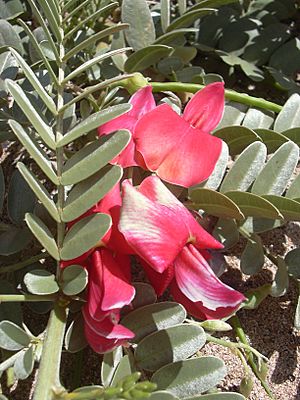Oahu riverhemp facts for kids
Quick facts for kids Oahu riverhemp |
|
|---|---|
 |
|
| Conservation status | |
| Scientific classification | |
| Kingdom: | |
| (unranked): | |
| (unranked): | |
| (unranked): | |
| Order: | |
| Family: | |
| Genus: |
Sesbania
|
| Species: |
Sesbania tomentosa
|
| Binomial name | |
| Sesbania tomentosa Hook. & Arn.
|
|
| Synonyms | |
|
Agati tomentosa (Hook. & Arn.) Nutt. ex A.Gray |
|
The Sesbania tomentosa, also known as Oahu riverhemp or ʻŌhai, is a special kind of flowering plant. It belongs to the pea family, called Fabaceae. This plant is endemic to Hawaii, which means it naturally grows only on the main Hawaiian Islands, Nihoa, and Necker Island. Sadly, it is an endangered species.
Contents
Meet the Ōhai Plant
The ʻŌhai plant is a unique part of Hawaii's nature. It is known for its beautiful flowers. This plant is very important to the local ecosystem. It shows how special and fragile island plants can be.
Where the Ōhai Lives
ʻŌhai plants usually live in low shrublands. Sometimes, you can find them in dry forests. They grow from sea level up to about 2,500 feet (762 meters) high.
Other native plants often grow nearby. These include akiʻaki (Sporobolus virginicus), ilima (Sida fallax), naupaka kahakai (Scaevola taccada), and pili (Heteropogon contortus).
Why Ōhai Plants Are in Danger
On the main Hawaiian Islands, the places where ʻŌhai grows have been harmed. Things like off-road vehicles, wildfires, and animals eating the plants (grazing) cause damage. Also, other plants that are not native to Hawaii compete with ʻŌhai for space and resources.
Luckily, ʻŌhai plants are still quite common on Nihoa and Necker Island. There are at least 2,000 plants on Nihoa. Necker Island has fewer, but they are still there.
How Ōhai Plants Look
ʻŌhai plants are very polymorphic. This means they can look quite different from each other. Their flowers and leaves can vary a lot in color and shape.
For example, plants growing on Nihoa have reddish-orange flowers. Their young leaves are also quite smooth, with not much hair. Plants on Necker Island have salmon to orange-colored flowers. Their leaves are very hairy.
On the island of Molokaʻi, there is a type of ʻŌhai that grows as a standing tree. On the southernmost tip of the island of Hawaiʻi, called Ka Lae, a different form grows. This one is a low, spreading shrub with smooth, bluish-green leaves.


